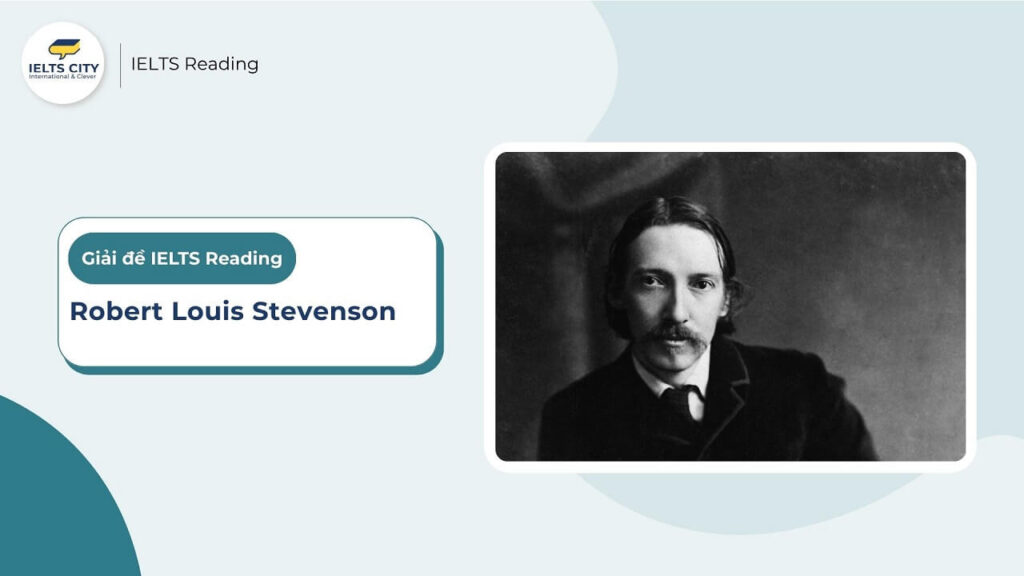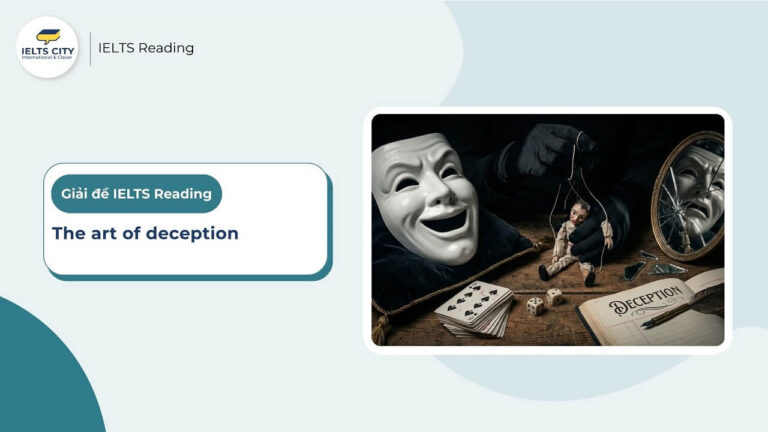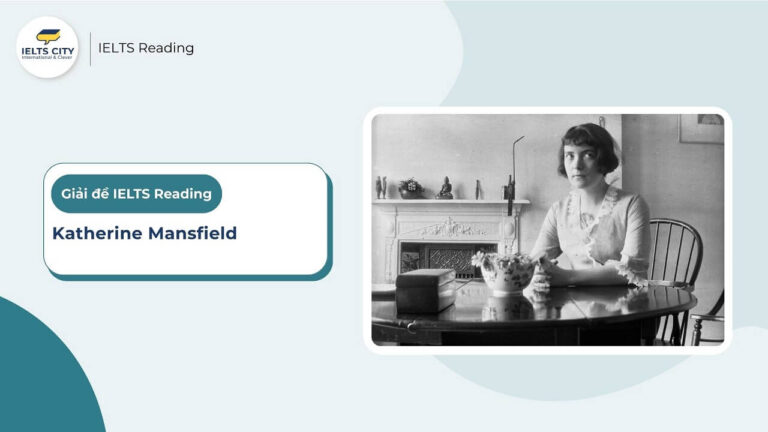
Nội dung chính
ToggleBài đọc
Robert Louis Stevenson
Scottish novelist, poet, essayist, and travel writer, Robert Louis Stevenson was born at 8 Howard Place, Edinburgh, Scotland, on 13 November 1850. It has been more than 100 years since his death. Stevenson was a writer who caused conflicting opinions about his works. On one hand, he was often highly praised for his expert prose and style by many English-language critics. On the other hand, others criticised the religious themes in his works, often misunderstanding Stevenson’s own religious beliefs. Since his death a century before, critics and biographers have disagreed on the legacy of Stevenson’s writing. Two biographers, KF and CP, wrote a biography about Stevenson with a clear focus. They chose not to criticise aspects of Stevenson’s personal life. Instead, they focused on his writing, and gave high praise to his writing style and skill.
The literary pendulum has swung these days. Different critics have different opinions towards Robert Louis Stevenson’s works. Though today, Stevenson is one of the most translated authors in the world, his works have sustained a wide variety of negative criticism throughout his life. It was like a complete reversal of polarity—from highly positive to slightly less positive to clearly negative; after being highly praised as a great writer, he became an example of an author with corrupt ethics and lack of moral. Many literary critics passed his works off as children’s stories or horror stories, and thought to have little social value in an educational setting. Stevenson’s works were often excluded from literature curriculum because of its controversial nature. These debates remain, and many critics still assert that despite his skill, his literary works still lack moral value.
One of the main reasons why Stevenson’s literary works attracted so much criticism was due to the genre of his writing. Stevenson mainly wrote adventure stories, which was part of a popular and entertaining writing fad at the time. Many of us believe adventure stories are exciting, offers engaging characters, action, and mystery but ultimately can’t teach moral principles. The plot points are one-dimensional and rarely offer a deeper moral meaning, instead focusing on exciting and shocking plot twists and thrilling events. His works were even criticised by fellow authors. Though Stevenson’s works have deeply influenced Oscar Wilde, Wilde often joked that Stevenson would have written better works if he wasn’t born in Scotland. Other authors came to Stevenson’s defence, including Galsworthy who claimed that Stevenson is a greater writer than Thomas Hardy.
Despite Wilde’s criticism, Stevenson’s Scottish identity was an integral part of his written works. Although Stevenson’s works were not popular in Scotland when he was alive, many modern Scottish literary critics claim that Sir Walter Scott and Robert Louis Stevenson are the most influential writers in the history of Scotland. While many critics exalt Sir Walter Scott as a literary genius because of his technical ability, others argue that Stevenson deserves the same recognition for his natural ability to capture stories and characters in words. Many of Scott’s works were taken more seriously as literature for their depth due to their tragic themes, but fans of Stevenson praise his unique style of story-telling and capture of human nature. Stevenson’s works, unlike other British authors, captured the unique day to day life of average Scottish people. Many literary critics point to this as a flaw of his works. According to the critics, truly important literature should transcend local culture and stories. However, many critics praise the local taste of his literature. To this day, Stevenson’s works provide valuable insight to life in Scotland during the 19th century.
Despite much debate of Stevenson’s writing topics, his writing was not the only source of attention for critics. Stevenson’s personal life often attracted a lot of attention from his fans and critics alike. Some even argue that his personal life eventually outshone his writing. Stevenson had been plagued with health problems his whole life, and often had to live in much warmer climates than the cold, dreary weather of Scotland in order to recover. So he took his family to a south pacific island Samoa, which was a controversial decision at that time. However, Stevenson did not regret the decision. The sea air and thrill of adventure complimented the themes of his writing, and for a time restored his health. From there, Stevenson gained a love of travelling, and for nearly three years he wandered the eastern and central Pacific. Much of his works reflected this love of travel and adventure that Stevenson experienced in the Pacific islands. It was as a result of this biographical attention that the feeling grew that interest in Stevenson’s life had taken the place of interest in his works. Whether critics focus on his writing subjects, his religious beliefs, or his eccentric lifestyle of travel and adventure, people from the past and present have different opinions about Stevenson as an author. Today, he remains a controversial yet widely popular figure in Western literature.
Kiến thức cần nắm
Câu hỏi
Questions 27-31
Choose the correct letter, A, B, C or D.
Write the correct letter in boxes 27-31 on your answer sheet.
27. Stevenson’s biographers KF and CP
A. Underestimated the role of family played in Stevenson’s life.
B. Overestimated the writer’s works in literature history.
C. Exaggerated Stevenson’s religious belief in his works.
D. Elevated Stevenson’s role as a writer.
28. The main point of the second paragraph is
A. The public gives a more fair criticism to Stevenson’s works.
B. Recent criticism has been justified.
C. The style of Stevenson’s works overweigh his faults in his life.
D. Stevenson’s works’ drawback is lack of ethical nature.
29. According to the author, adventure stories
A. Do not provide plot twists well.
B. Cannot be used by writers to show moral values.
C. Are more fashionable art forms.
D. Can be found in other’s works but not in Stevenson’s
30. What does the author say about Stevenson’s works?
A. They describe the life of people in Scotland.
B. They are commonly regarded as real literature.
C. They were popular during Stevenson’s life.
D. They transcend the local culture and stories.
31. The lifestyle of Stevenson
A. Made his family envy him so much.
B. Should be responsible for his death.
C. Gained more attention from the public than his works.
D. Didn’t prepare well for his life in Samoa.
Kiến thức cần nắm:
Questions 32-35
Do the following statements agree with the information given in the Reading Passage?
In boxes 32-35 on you answer sheet, write
TRUE – if the statement is true
FALSE – if the statement is false
NOT GIVEN – if the information is not given in the passage
32. Although Oscar Wilde admired Robert Louis Stevenson very much, he believed Stevenson could have written greater works.
33. Robert Louis Stevenson encouraged Oscar Wilde to start writing at first.
34. Galsworthy thought Hardy is greater writer than Stevenson is.
35. Critics only paid attention to Robert Louis Stevenson’s writing topics
Kiến thức cần nắm:
Questions 36-40
Complete the notes using the list of words, A-I, below.
Sir Walter Scott and Robert Louis Stevenson
A lot of people believe that Sir Walter Scott and Robert Louis Stevenson are the most influential writers in the history of Scotland, but Sir Walter Scott is more proficient in 36…….., while Stevenson has better 37…………….. Scott’s books illustrate 38……………, especially in terms of tragedy, but a lot of readers prefer Stevenson’s 39…………. What’s more, Stevenson’s understanding of 40………. made his works have the most unique expression of Scottish people.
A. Natural ability
B. Romance
C. Colorful language
D. Critical acclaim
E. Humor
F. Technical control
G. Storytelling
H. Depth
I. Human nature
Kiến thức cần nắm:
Đáp án kèm phân tích
Questions 27-31: Multiple Choice
27. Stevenson’s biographers KF and CP
- Đáp án: D. Elevated Stevenson’s role as a writer.
- Giải thích: Đoạn 1 nói rằng hai nhà viết tiểu sử này đã chọn không chỉ trích đời tư của Stevenson. Thay vào đó, họ “tập trung vào các tác phẩm của ông, và hết lời ca ngợi phong cách và kỹ năng viết lách của ông” (focused on his writing, and gave high praise to his writing style and skill). Việc “hết lời ca ngợi” (gave high praise) chính là nâng cao vai trò của ông với tư cách là một nhà văn.
- Vị trí và trích dẫn: Đoạn 1, câu cuối.”Instead, they focused on his writing, and gave high praise to his writing style and skill.”
28. The main point of the second paragraph is
- Đáp án: D. Stevenson’s works’ drawback is lack of ethical nature.
- Giải thích: Đoạn 2 mô tả sự thay đổi trong cách các nhà phê bình nhìn nhận tác phẩm của Stevenson. Trọng tâm của sự chỉ trích là tác phẩm của ông bị coi là truyện trẻ con hoặc truyện kinh dị và “thiếu giá trị đạo đức” (lack of moral). Câu cuối cùng của đoạn cũng nhấn mạnh rằng nhiều nhà phê bình vẫn cho rằng tác phẩm của ông “thiếu giá trị đạo đức” (lack moral value).
- Vị trí và trích dẫn: Đoạn 2.”…he became an example of an author with corrupt ethics and lack of moral.” và “These debates remain, and many critics still assert that despite his skill, his literary works still lack moral value.”
29. According to the author, adventure stories
- Đáp án: B. Cannot be used by writers to show moral values.
- Giải thích: Đoạn 3 giải thích lý do tại sao thể loại truyện phiêu lưu của Stevenson bị chỉ trích. Tác giả nêu lên quan điểm phổ biến rằng truyện phiêu lưu “cuối cùng không thể dạy các nguyên tắc đạo đức” (ultimately can’t teach moral principles).
- Vị trí và trích dẫn: Đoạn 3, câu 2.”Many of us believe adventure stories are exciting… but ultimately can’t teach moral principles.”
30. What does the author say about Stevenson’s works?
- Đáp án: A. They describe the life of people in Scotland.
- Giải thích: Đoạn 4 nêu bật mối liên hệ giữa Stevenson và Scotland. Tác giả khẳng định rằng các tác phẩm của Stevenson, không giống như các tác giả Anh khác, đã “nắm bắt được cuộc sống đời thường độc đáo của những người Scotland bình thường” (captured the unique day to day life of average Scottish people).
- Vị trí và trích dẫn: Đoạn 4, câu 6.”Stevenson’s works, unlike other British authors, captured the unique day to day life of average Scottish people.”
31. The lifestyle of Stevenson
- Đáp án: C. Gained more attention from the public than his works.
- Giải thích: Đoạn 5 nói rằng một số người cho rằng đời tư của ông cuối cùng đã “làm lu mờ các tác phẩm của ông” (outshone his writing). Đoạn văn cũng đề cập đến cảm giác rằng “sự quan tâm đến cuộc đời của Stevenson đã thay thế cho sự quan tâm đến các tác phẩm của ông” (interest in Stevenson’s life had taken the place of interest in his works).
- Vị trí và trích dẫn: Đoạn 5.”Some even argue that his personal life eventually outshone his writing.” và “It was as a result of this biographical attention that the feeling grew that interest in Stevenson’s life had taken the place of interest in his works.”
Đăng ký nhận tư vấn miễn phí
Ưu đãi học phí lên đến 40%
& Cơ hội nhận học bổng trị giá 2.000.000 VNĐ
Đăng ký nhận tư vấn miễn phí
Ưu đãi học phí lên đến 40%
________
Questions 32-35: TRUE / FALSE / NOT GIVEN
32. Although Oscar Wilde admired Robert Louis Stevenson very much, he believed Stevenson could have written greater works.
- Đáp án: TRUE
- Giải thích: Đoạn 3 nói rằng các tác phẩm của Stevenson đã ảnh hưởng sâu sắc đến Oscar Wilde, cho thấy sự ngưỡng mộ. Tuy nhiên, Wilde cũng nói đùa rằng Stevenson “lẽ ra đã viết được những tác phẩm hay hơn nếu ông không sinh ra ở Scotland” (would have written better works if he wasn’t born in Scotland). Điều này khớp hoàn toàn với câu nhận định.
- Vị trí và trích dẫn: Đoạn 3, câu 4.”Though Stevenson’s works have deeply influenced Oscar Wilde, Wilde often joked that Stevenson would have written better works if he wasn’t born in Scotland.”
33. Robert Louis Stevenson encouraged Oscar Wilde to start writing at first.
- Đáp án: NOT GIVEN
- Giải thích: Bài đọc chỉ đề cập rằng các tác phẩm của Stevenson đã “ảnh hưởng sâu sắc” đến Oscar Wilde. Hoàn toàn không có thông tin nào nói về việc Stevenson có khuyến khích Wilde bắt đầu viết văn hay không.
34. Galsworthy thought Hardy is greater writer than Stevenson is.
- Đáp án: FALSE
- Giải thích: Câu này nói rằng Galsworthy nghĩ Hardy vĩ đại hơn Stevenson. Tuy nhiên, bài đọc lại nói điều ngược lại. Galsworthy đã bênh vực Stevenson và tuyên bố rằng “Stevenson là một nhà văn vĩ đại hơn Thomas Hardy” (Stevenson is a greater writer than Thomas Hardy).
- Vị trí và trích dẫn: Đoạn 3, câu cuối.”…Galsworthy who claimed that Stevenson is a greater writer than Thomas Hardy.”
35. Critics only paid attention to Robert Louis Stevenson’s writing topics.
- Đáp án: FALSE
- Giải thích: Câu này nói rằng các nhà phê bình chỉ quan tâm đến chủ đề sáng tác của Stevenson. Điều này không đúng. Đoạn 5 mở đầu bằng câu: “chủ đề sáng tác của Stevenson không phải là nguồn chú ý duy nhất” (his writing was not the only source of attention). Đoạn văn sau đó mô tả sự quan tâm đến đời tư, sức khỏe và các chuyến đi của ông. Câu cuối của bài đọc cũng tóm tắt các yếu tố khác nhau mà các nhà phê bình tập trung vào: “chủ đề sáng tác, niềm tin tôn giáo, hoặc lối sống lập dị” (writing subjects, his religious beliefs, or his eccentric lifestyle).
Questions 36-40: Complete the notes
36. F. Technical control
- Giải thích: Câu này so sánh Scott và Stevenson. Đoạn 4 nói rằng nhiều nhà phê bình ca ngợi Sir Walter Scott là một thiên tài văn học vì “khả năng kỹ thuật” (technical ability) của ông. “Technical control” là một cụm từ đồng nghĩa.
- Vị trí và trích dẫn: Đoạn 4, câu 3.”…many critics exalt Sir Walter Scott as a literary genius because of his technical ability…”
37. A. Natural ability
- Giải thích: Vế câu này đối lập với Scott, nói về điểm mạnh của Stevenson. Đoạn 4 nói rằng những người khác cho rằng Stevenson xứng đáng được công nhận vì “khả năng thiên bẩm trong việc nắm bắt câu chuyện và nhân vật” (natural ability to capture stories and characters in words).
- Vị trí và trích dẫn: Đoạn 4, câu 3.”…others argue that Stevenson deserves the same recognition for his natural ability to capture stories and characters in words.”
38. H. Depth
- Giải thích: Câu này nói về các tác phẩm của Scott. Đoạn 4 đề cập rằng nhiều tác phẩm của Scott được xem là văn học nghiêm túc hơn vì “chiều sâu do chủ đề bi kịch của chúng” (depth due to their tragic themes).
- Vị trí và trích dẫn: Đoạn 4, câu 4.”Many of Scott’s works were taken more seriously as literature for their depth due to their tragic themes…”
39. G. Story-telling
- Giải thích: Vế câu này nói về điều mà người hâm mộ Stevenson yêu thích. Đoạn 4 nói rằng “người hâm mộ Stevenson ca ngợi phong cách kể chuyện độc đáo của ông” (fans of Stevenson praise his unique style of story-telling).
- Vị trí và trích dẫn: Đoạn 4, câu 4.”…but fans of Stevenson praise his unique style of story-telling…”
40. I. Human nature
- Giải thích: Câu này đề cập đến sự thấu hiểu của Stevenson. Cũng trong câu trích dẫn cho câu 39, người hâm mộ ca ngợi phong cách kể chuyện và “sự nắm bắt bản chất con người” (capture of human nature) của ông.
- Vị trí và trích dẫn: Đoạn 4, câu 4.”…and capture of human nature.”
Cập nhật đề thi thật Reading mới nhất tại:





















